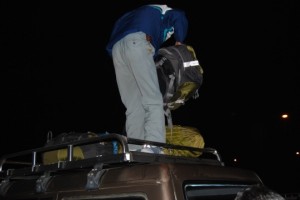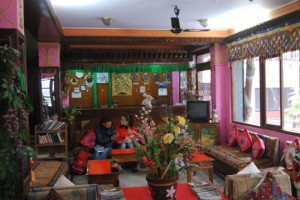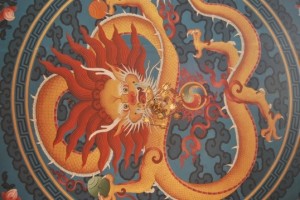Cruising Kathmandu or It's Finally Foreign""
December 6, 2011
Wow, wow and wow!
Nepal is a different place.
It is rural Mexico, but without the hygiene standards. This place longs for squalor – it would be an upgrade.
It is Jamaica, except without the intensity. When Virginia was in the cab without a seatbelt – no problem. When all of our luggage was atop a van without cords – no problem.
It is crowded and cramped.
Yet we are having a blast in Kathmandu.
Perhaps this is the best summary of how different Nepal is. The country is two hours and fifiteen minutes behind Hong Kong. What is the purpose of the extra 15 minutes other than to say “we just do not fit into the standard mold”. Frankly, I kinda wish they had chosen to be off by 17 minutes and 23 seconds, but perhaps I am a rebel.
We arrived at the Katmandu International Airport yesterday night around 10:30 pm (that would be 12:45 Hong Kong time) and it was surreal.
Here is a picture of the largest airport in Nepal.
The boys said it looked like an ad for post-apocalyptic videos games – mist, unfinished structures, sketchy characters and low lighting. By low lighting, I mean LOW lighting. Katmandu has rolling blackouts for 6 hours everyday. The blackouts are scheduled and vary by district. Hotels post the schedule for the 6 hours each day they will be without electricity.
In the States, we do not like people telling us when we can water our lawns. Here, you go dark 25% of every day. The other 75% has very few lights. I suspect that the typical Wal-Mart parking lot emits more lumens than 3 city blocks dohere.
In the airport, they decided it was too much effort to have us take off our backpacks, so they waived us through the customs security check unsearched.
Wiley turned to me and asked, “Did they just avoid procedures because it was too much effort?”
“Yes, I think so.”
“I can appreciate these people.”
Liam kept staring. If you will recall, Liam blithely declared that China “did not feel foreign” to him. He looked at me and said, “yep, this is feeling foreign. Really, really foreign.”
As I alluded to above, the ride back involved stacking our 6 backpacks on top of a van, shoving the 3 big kids into the back of the van (no actual seats) and putting Virginia in the front seat with the driver and porter (but no seatbelt). Susie kept asking “is there a seatbelt?” “No problem” came back. They were perplexed as Susie held Virginia from behind for the 15 minute ride.
When we got to the “luxury hotel”, we woke the front desk workers who were sleeping in the lobby (where would you have them sleep?
The basement or a closet? Sheesh – where is your compassion?) They got up, checked us in and spent 10 minutes trying to spell the wifi password (would you have guessed that ‘management’ would sound like “manezent’ – they did).
We work up, ate a Nepalese breakfast just as the lights went out. I looked up expecting to see the staff sprinting to find the breaker. No one moved. No one seemed surprised. I eventually asked what was happening.
“Everyone gets 6 hours off.”
“From what?”
“Electricity.”
“You have rolling blackouts for 6 hours every day?”
“Yes.”
While the power was going off, we were meeting with Tsedo, a Tibetan refugee that has become a dear friend of a business school classmate of Susie’s named Susie Silver. Susie Silver is an accomplished traveller, particularly in Asia. Tsedo is smart, knowledgeable, and honest to a fault. He has helped us with flights, hotels, home stays, permits and guides.
He also set us up with a driver who took us to the two great religious sites in Kathmandu – one Buddhist and one Hindu.
The Buddhist site (Boudhanath) was an intriguing visit.
We saw pilgrims who have come long distances to circle the “stupa” (shrine) and perform the ritual of the Kora – circling the building in a clockwise fashion and turn the prayer wheels and recite mantras. We visited the monastery and saw exotic icons.
We then hopped into our van and drove to the most important Hindu site in Nepal (or so several people insisted to us), Pashupatinath.
This place was truly singular in my experience. It was not particularly striking. In fact, it was hard to tell where holy ground ended and random structures began.
In fact, it is hard to describe our experience as we arrived at Pashupatinath.
We arrive along a path that took us past vendors and then to a river. The river is shallow, dirty and heavily polluted. In this polluted river, we saw people washing clothes, rinsing their hands and even (please tell me this is not true) drawing water.
Smoke wafted downstream, making the detritus even more unappealing.
It was then that I heard the wails.
Soul-crushing wails. Tears. Mourning.
My eye turned up to see the pyres.
Funeral pyres.
Five were burning at different stages. One was practically ashes. Others were still in full flame.
We watched as a man pushed some burnt material into the river. I would like to think it was wood, but I do not think so. I do not know how much heat is necessary to completely incinerate a human form, but I doubt these pyres were sufficient.
As the ashes/embers/material fell into the river, I watched a child fetch a soccer ball from the water as his mom washed laundry that must surely contain some of the cremation.
We then became fascinated by the ceremony across from us. It was the source of the wails.
Here is what we saw. A body wrapped in red silk with gold trim was being lifted onto a bed of wood. Mourners circled the body, placing flowers and dyed powder on it.
They participants put water and (I think) milk into the corpse’s mouth. They put jewelry and money on the body.
[Note – at one point, the jewelry and money were cast into the river. Moments later, a young boy strolled across the river and retrieved most of it form the water.]
Near the end of the ceremony a woman and a man circle the body three times. They also put water in the mouth. They then took a lit bundle of straw and circled it another three times. She then placed the flame against the face, wept massively and sat down.
I think we watched this for 20-25 minutes, but I cannot be sure. It seemed endless, yet instantaneous. The emotion was raw and the ceremony well-rehearsed, though deeply foreign. We would later learn more about the meaning and preparation of the ceremony from a friendly guide, but nothing will erase the purity of the experience.
Part of the purpose of funerals is to provide a familiarity that helps us deal with grief. They help us become more comfortable – they give us a context to understand loss.
Sitting on a squalid riverbank hearing sadness and watching bodies burn shoved the humanity of death in my face. It was solemn and powerful, despite the soccer game and the roaming onlookers.
We then toured the rest of the temple complex. We soon saw what makes this place particularly famous.
Monkeys. Lots and lots of monkeys. We saw momma monkeys and baby monkeys and alpha male monkeys and swarms of monkeys. Apparently, the inhabitants of the temple feed them daily. Clearly, they are not going anywhere.
We also met some “holy men”. They were extremely odd, but surprisingly friendly. They invited us to join them for a photo (OK, we gave them a few dollars, but they were WAY more excited than $4 justified).
The last time all four of our kiddos were openly impressed was the Sagrada Familia in Barcelona. Usually, at least one feigns indifference to look sophisticated or cool. Not then. Not now. Pashupatinath left an impression.
Steve Sir












